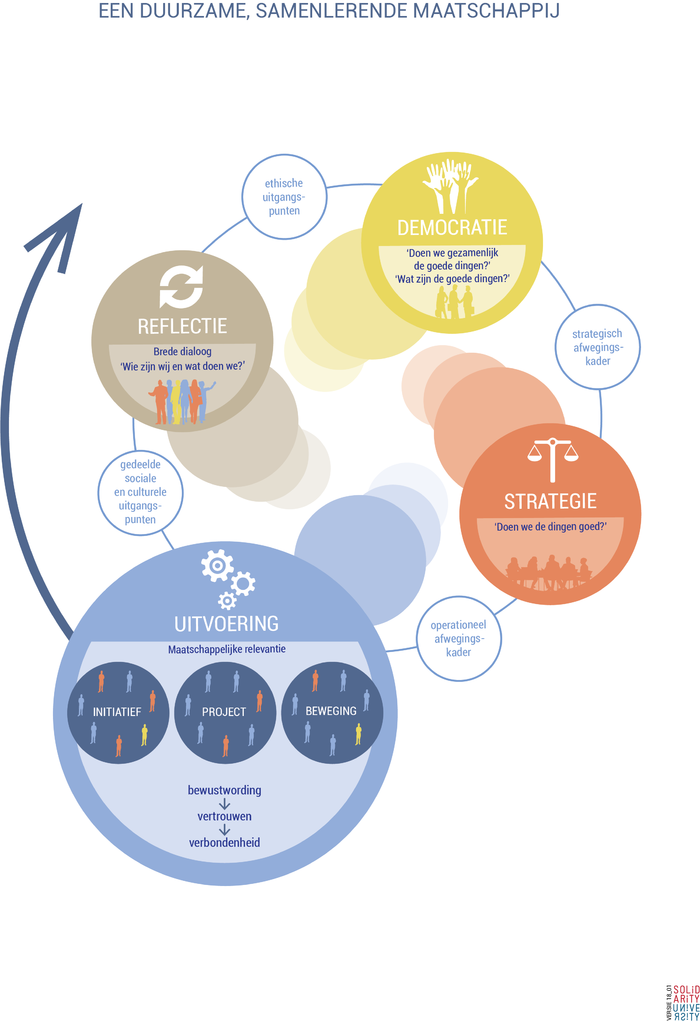LC 00347: verschil tussen versies
Geen bewerkingssamenvatting |
Geen bewerkingssamenvatting |
||
| Regel 13: | Regel 13: | ||
[[Bestand:Sociale theorie dsm.png|gecentreerd|miniatuur|1021x1021px|'''Figuur:''' Sociale Theorie van de Duurzame Samenlerende Maatschappij.]] | [[Bestand:Sociale theorie dsm.png|gecentreerd|miniatuur|1021x1021px|'''Figuur:''' Sociale Theorie van de Duurzame Samenlerende Maatschappij.]] | ||
{{LC Book config}} | {{LC Book config}} | ||
| Regel 28: | Regel 30: | ||
|Show VE button=Ja | |Show VE button=Ja | ||
|Show title=Ja | |Show title=Ja | ||
}} | |||
}} | |||
{{LC Book additional | {{LC Book additional | ||
|Preparatory reading=LC 00346, LC 00359, LC 00455, LC 00419 | |Preparatory reading=LC 00346,LC 00359,LC 00455,LC 00419 | ||
|Continue reading=LC 00352 | |Continue reading=LC 00352 | ||
}} | }} | ||
Versie van 22 jun 2020 13:02
The Social Theory (ST) process is geared towards discovering a shared meaning on the basis of mutual understandings. It is a circular, never ending process that continuously reassesses lessons learned from concrete activities. So, shared meaning is not carved in stone. It is part of our tradition, which evolves as result of changing circumstances that requires to reconsider our relation with the outside world, including advancements in science and technology.
Geleerde les: Tradition, shared meaning
Samenvatting:
Tradition is overarching.
Context:
Stakeholders' worldviews may differ.
- Traditie heeft ons gevormd in wat we zijn en wat we doen;
- Het is onze cultuur die niet zomaar kan worden weggepoetst omdat er betere (rationele) aanpakken voorhanden zijn om wicked problemen aan te pakken.
- De cultuur van wetenschap is ook een traditie onderhavig aan nieuwe inzichten;
- We kunnen niet ontsnappen aan traditie: traditie is overkoepelend, maar evolueert.
Learning takes place on at least two levels. The first learning level is about understanding the ins and outs of the problematic situation at hand. The second learning level is to understand the ST process itself and to acquire the skills to be engaged in the ST process. (And yet at another level, the originators of EMM and ST learn from these learnings.)
The circular ST process is shown below. It is comprised of four main processes that transform a given input to some output. This corresponds to the classical conception of systems thinking in which a system performs a purposeful input-output transformation (see …). The overarching, circular ST process, however, adheres to the second-order system concept of self-producing in order to sustain itself in changing circumstances (see …). The reason of being (raison d’être) is our cultural identity expressed as “what we are” and observed in “what we do”.
Geleerde les: Reflexive domain
Samenvatting:
We are living in a reflexive domain in which cause and effect coincide.
Context:
Stakeholders' worldviews may differ.
- Een oorzaak van een probleem is vaak niet eenduidig aan te geven, hoewel dat wel vaak gebeurt (menselijke natuur);
- Er treden allerlei wisselwerkingen op: mensen reageren op elkaar;
- Met wie of met wat iets begon is niet zo relevant, de vraag is; hoe kunnen we de wisselwerkingen beïnvloeden z.d.d. collectief de juiste dingen gaan doen.
Geleerde les: Feedback loops
Samenvatting:
A system comprised of a number of interacting feedback loops is a complex system whose behavior can surprise us.
Context:
Stakeholders' worldviews may differ.
- Fysieke en sociale fenomenen zijn niet eenvoudig te verklaren als gevolg van de onderliggende, vaak of niet observeerbare onderstromen in de vorm van interacterende feedback loops;
- Het gevaar ligt dan op de loer dat we verkeerde conclusies trekken die leiden tot spraakverwarringen of in het ergste geval onoverbrugbare tegenstellingen.
Geleerde les: We got to move
Samenvatting:
We have to become what we are not, and yet remain the same.
Context:
Stakeholders' worldviews may differ.
- Mensen in een samenleving moeten constant met elkaar in gesprek zijn, of anders, in het ergste verhaal, houdt een samenleving op te bestaan of valt uiteen in deelsamenlevingen;
- We moeten naar elkaar toe bewegen (we have to become what we are not), op basis van gedeelde waarden en normen, zoals vrijheid, democratie en rechtstaat (and yet remain the same);
- De constante factor is dus bewegen, maar in een fysieke en sociale ruimte die ons bindt.
Geleerde les: Movement
Samenvatting:
The constant factor in life is movement.
Context:
Stakeholders' worldviews may differ.

